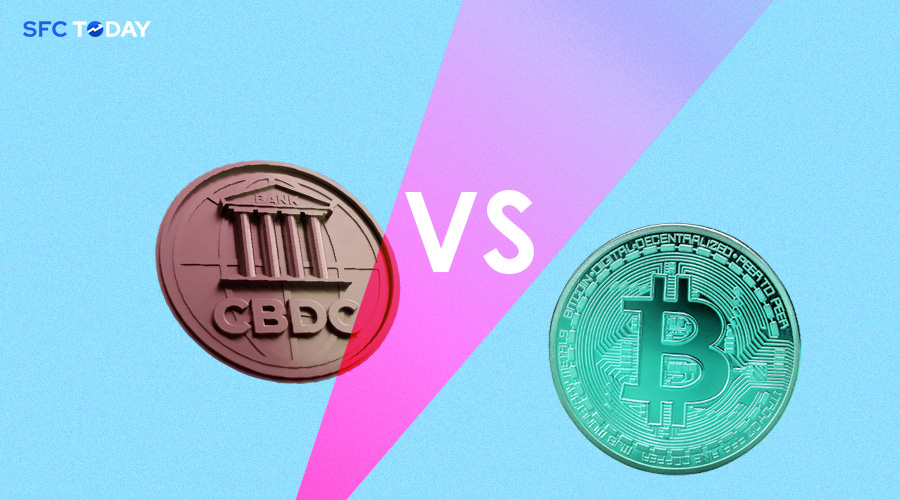Unveiling the key differences of CBDCs vs. Crypto, the future of digital currency!
In the ever-changing universe of digital currencies, the distinction between Central Bank Digital Currencies (CBDCs) and cryptocurrencies has aroused intense controversy. While these two types of digital money have certain similarities, they differ greatly in their underlying ideas, governance systems, and possible financial repercussions. This essay dives into the distinguishing qualities of CBDCs and cryptocurrencies, shining light on their unique properties and the consequences for the future of finance.
Central Bank Digital Currencies (CBDCs):
CBDCs are the digital progression of traditional fiat currencies, intended to coexist with real currency. CBDCs, unlike cryptocurrencies, are centralized digital currencies issued and regulated by central banks. They operate inside established financial institutions and are subject to government rules and regulations. The fundamental goal of CBDCs is to modernize payment systems, streamline monetary rules, and enable speedier digital transactions. CBDCs are embedded in the current financial system, enabling potential efficiency while raising concerns about access hurdles and privacy risks.
Cryptocurrencies:
In contrast, cryptocurrencies arose as a decentralized alternative to traditional fiat currencies, fueled by blockchain technology. Cryptocurrencies operate on distributed ledger systems, eliminating the need for middlemen like as banks or governments, giving consumers transparency and control over their transactions. The decentralized structure of cryptocurrencies has attracted proponents who value user privacy and financial transparency, despite legal and governance issues.
Key Differences Between CBDCs and Cryptocurrencies
Issuance
Central Bank Central banks create and oversee digital currencies (CBDCs), ensuring that they are government-backed and comply with financial rules. In contrast, cryptocurrencies like Bitcoin are usually produced through mining or other consensus methods inside decentralized networks, independent of central authority.
Regulation
CBDCs are subject to stringent government controls and monitoring, which ensures compliance with financial laws and policies. Cryptocurrencies, on the other hand, operate with less governmental authority, allowing for more freedom while also raising worries about security and stability.
Stability
CBDCs are intended to be stable digital representations of a country’s fiat currency, with a constant value compared to the underlying currency. In contrast, cryptocurrencies are notorious for their price volatility, with values shifting dramatically dependent on market demand and speculation
Purpose
CBDCs are primarily intended to upgrade current fiat currency systems by digitizing them, hence improving transaction and monetary policy efficiency. Cryptocurrencies were first designed as an alternative to existing currencies and financial institutions, with the goal of decentralization and autonomy from centralized authority.
In summary, the key difference between CBDCs and crypto lies in their issuance, regulation, stability, and intended purpose. While CBDCs focus on digitizing traditional currencies under governmental control for stability and efficiency, cryptocurrencies prioritize decentralization and independence from centralized financial systems despite their inherent volatility and regulatory challenges.
Regulatory Landscape and Adoption
Cryptocurrencies operate in a complicated regulatory framework with several methods to oversight. Central Bank Digital Currencies (CBDCs), which are issued by central banks, may have better regulatory frameworks inside their issuing nations. Despite regulatory hurdles, CBDCs and cryptocurrencies have the potential to alter the financial environment. They provide more efficient, inclusive, and secure transactions, transforming traditional banking and finance. Balancing innovation and regulatory compliance will be critical to obtaining these advantages as the regulatory landscape changes.
The Future of Money: Convergence or Competition?
The ever-changing environment of central bank digital currencies (CBDCs) and cryptocurrencies is shaping the future of money. There is a discussion over whether various digital currencies will converge, coexist in a multifaceted monetary ecology, or compete, resulting in a consolidation around a single dominant form.
Technological advancements, including blockchain and distributed ledger technologies, are driving innovation in digital currencies. Regulatory frameworks are also evolving to accommodate these changes, with some governments embracing digital currencies and others adopting a more cautious approach.
Societal trends toward digitalization, accelerated by the global pandemic, further blur the lines between physical and digital money. The outcome of this battle will likely be influenced by a combination of technological progress, regulatory decisions, and societal preferences, ultimately shaping the future landscape of money.
In conclusion, the contrasting features of CBDCs vs crypto underscore the transformative potential of digital currencies in reshaping financial systems globally. Understanding the nuances between these two forms of digital currency is essential for making informed decisions about their adoption and navigating the evolving landscape of digital finance.







